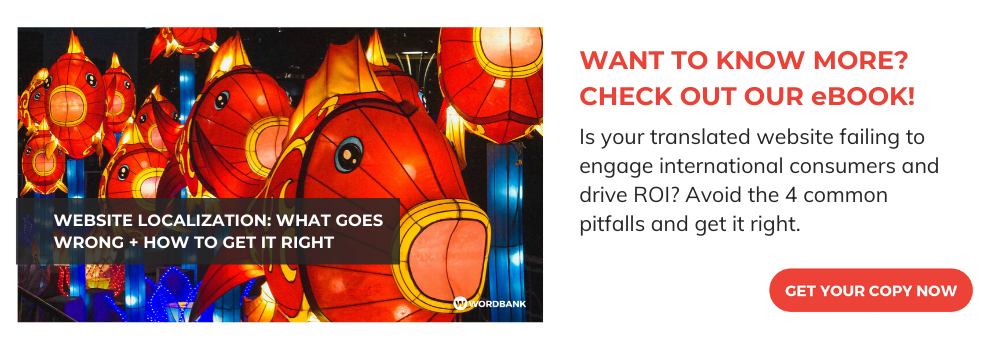Website localization is about adapting the content of your website to deliver a user experience that’s as compelling to international audiences as it is to your US visitors. Successful website localization enables international consumers to relate to your message, trust your brand, and – ultimately – become customers.
Truly effective website localization is iterative, and based on actionable, measurable insights. Here are four steps to getting it right.
1. KNOW YOUR AUDIENCE
While companies clearly see the value of websites in reaching domestic consumers, they frequently fail to connect with what the international consumer is looking for in their website experience. Some companies fail to localize at all, assuming that international customers will buy in English. Others stop short at translation and fail to consider that the localized experience they provide is critical to their competitive positioning and long-term success in international markets.
Taking the time to understand what drives international consumers can make all the difference. Language is just one piece of the puzzle. Online behavior varies greatly from market to market. You need to know about each market’s digital platform trends, UX expectations related to navigation, imagery/text ratios, form functionality, shopping cart functionality, and payment options.
Whether you’re operating an eCommerce site or selling B2B products and services reliant on lead generation, it’s folly to assume that international consumers will connect with, engage, and convert in the same way as US domestic consumers.
You have to know what your audience wants – and how they behave – to get it right.
2. LOCALIZE + OPTIMIZE
Once you know more about the international markets you’re localizing for, the next step is focusing on which website content is relevant for each locale.
If budget is tight, be selective. Don’t opt for low-cost translation to meet budget constraints because it’s quality, not quantity, that counts. Avoid the temptation to translate everything unless there is a clear benefit in doing so. Key page identification can help define which parts of your website are most relevant to your target markets. Focus on those as a starting point.
Translate smaller amounts of highly targeted, relevant content, and avoid one-size-fits-all translation solutions. Don’t overshoot on high-volume translation before you have the data to support its value and the strategy to promote that content.
Focus on delivering an authentic and competitive user experience. And allocate localization budgets to the most relevant website content for your audience. Doing so will help you get the most from your budget, develop a website localization strategy informed by in-country trends and data, and make the case for localization based on results.
3. PROMOTE YOUR CONTENT
Your content may be localized well and targeted at the markets with the best potential for ROI. But if your international audience can’t find your website (whether that’s through search or social), you’re missing the mark.
Your website and your digital efforts should work together to drive brand awareness and lead generation. Be sure to use local digital platforms to drive interest, generate leads, and measure ROI. And keep in mind that every locale differs. Digital marketing strategy that works in one international market may not work for another.
You also need to have a strategy in place for international paid search. Straight keyword translation doesn’t take into account local search volume, linguistic nuance, intent, or consumer behavior. To get results in-market, it’s critical to perform keyword research in-country, and on the market’s dominant search engine(s). For example, Yamli, Eiktub, and Yoolki are best for targeting Arabic speakers in the UAE. Or if you’re marketing in China, you’ll want to go with Baidu.
Search and social tactics will drive brand awareness and credibility with international audiences. Then you can use that data to both refine and expand your website localization needs at the local level.
4. MEASURE, ITERATE, EXPAND
Traditional LSPs often talk about ROI in terms of content reuse, quality, and other savings-based activities. But international marketing is an investment in the growth of your business. So measuring your website’s ROI is really about in-market performance against key business indicators: traffic, engagement, conversions, and sales.
The best way to measure your efforts is to set up a regular, cross-tactic reporting cadence for each of your markets. This practice is key to understanding what’s resonating with your international audiences. You should also examine data about your audience to discover how they relate to your brand. For example, some markets may prefer people-focused content while others value data and stats.
Once you have solid data to determine what’s working and what’s not, you can expand your website localization activities and budget in the markets that show the most promise. Through regular review and iteration, you can evolve your digital strategy based on in-market performance data. And you can refine your locale-specific strategy while also determining which markets make the most sense for expansion.
FINAL THOUGHT ON WEBSITE LOCALIZATION
Companies often jump into website localization as a purely technical endeavor, place emphasis on translation as the goal, consider optimization as an afterthought, and fail to plan for the need to measure and iterate at the local level.
However, developing a multilingual website should be driven by clear content marketing objectives that recognize the importance of the international customer journey and amplify your opportunity to connect and engage with potential customers from awareness to conversion.








